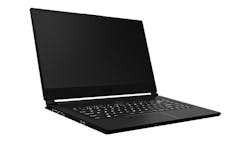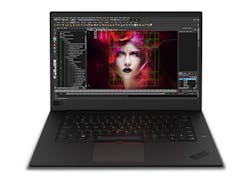The big news at SIGGRAPH was NVIDIA’s RTX 8000 ray-tracing technology, but it will be a while before those boards can be crammed into a laptop. On the other hand, NVIDIA has been working with laptop vendors to provide high-performance video in a lightweight package.
I took a look at MSI’s WS65 and Lenovo’s P1 at SIGGRAPH. These mobile workstations target power users and balance performance with portability.
The MSI WS65 can pack Intel’s high-end, Core-i9 processor along with NVIDIA’s P4200 GPU (Fig. 1). The laptop, which is 40% faster than the previous generation, contains an 82-Wh battery to deliver eight hours of battery life.
1. The MSI WS65 can handle an Intel Core-i9 and includes an NVIDIA P4200 GPU.
“With an Intel Core i9 processor and NVIDIA Quadro P4200 graphics, the WS65 is a breakthrough for slim, portable workstations,” said Clifford Chun, System Product Management Director at MSI. "It's a beautiful laptop that will easily fit into any business scenario, but is more than powerful enough for even the most demanding workloads."
The WS65’s display is a 15.6-in. full HD IPS display. Designed to deliver 72% coverage of the NTSC color gamut, it’s driven by the 16-nm P4200 GPU that is based on NVIDIA’s Pascal architecture. It features 8 GB of GDDR5 memory using a 256-bit memory interface. There are 2304 shading units, 144 texture mapping units, and 64 raster operators (ROPs). It supports Microsoft Windows DirectX 12.
Pushing the performance limits of the WS65 tends to generate a bit of heat, so MSI designed the system to keep the electronics cool (Fig. 2). Three fans and multiple heat pipes distribute the load. The case has openings on the bottom and sides to allow for clear airflow. Normally, the system slows down the processor and GPU so that the fans barely run with faster fan speeds as more performance is required.
2. Sophisticated cooling techniques handle the Core-i9 and the NVIDIA GPU in the WS65.
The motherboard supports one M.2 module with a PCIe/SATA interface and one with just a PCIe interface. The PCIe interfaces support NVMe. Also included are a single USB 3.1 Type-C interface and three USB 3.1 Type-A sockets. In addition, the laptop has one HDMI 2.0 port and one mini-DisplayPort (mDP) 1.4. For audio, there’s a mic-in and headphone-out jacks.
Lenovo’s Thinkpad P1 (Fig. 3) takes the thin (14.2 × 9.7 × 0.7 in.) and light (3.76 lbs.) route with its enterprise offering. The top end offers an Intel 8th-generation Core i7-8850H with six cores, a 9-MB cache, and vPro support, or an Intel Xeon E-2176M with six cores, a 12-MB cache, and vPro support. The battery is designed to give 13 hours of average use.
3. Lenovo’s Thinkpad P1 supports Intel Core-i7 with vPro and Xeon E2176M processors, along with NVIDIA’s Quadro P2000 with 4 GB of GDDR5.
The systems support up to 64 GB of 2666-MHz DDR4 memory or 32 GB with ECC support. They also pack up to 4 TB of M.2 NVMe flash memory.
The 15.6-in display is available as a 1080p or a bright (400 nit) 4K UHD (3840 by 2160 pixel) resolution. The latter is a multi-touch display with 10-bit color depth supporting 100% Adobe color gamut. The displays are driven by NVIDIA’s P2000 GPU with 4 GB of GDDR5 memory.
4. The Thinkpad P1 has two USB Type-C Thunderbolt sockets, a full HDMI socket, and a mini-Gigabit Ethernet socket.
The laptop keeps its thin profile with two USB Type-C Thunderbolt sockets, a microphone/headphone combo jack, a full HDMI socket, and a mini-Gigabit Ethernet socket (Fig. 4). An adapter cable comes with an RJ45 jack; incorporating the jack into the laptop would require a thicker design. The other side of the laptop has two USB 3.1 Gen1 Type-A connectors, an SD card reader, and an optional Smart Card slot. There’s also a Kensington lock slot.






